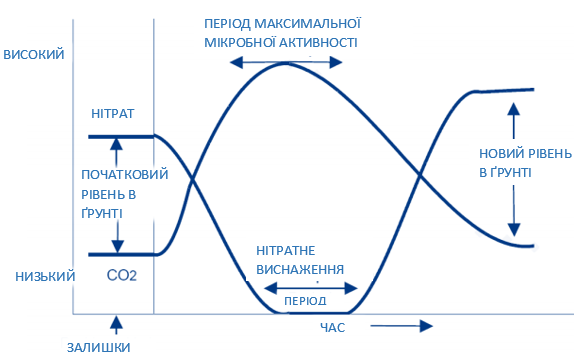Soil microorganisms
The soil contains a huge population of living organisms, most of which are too small to be seen without any increase. These are bacteria, actinomycetes, fungi, protozoa, algae, yeast, worms and insects. One gram of soil can contain: up to a billion bacteria, 15 million actinomycetes, a million fungi and protozoa, 100,000 algae and 1,000 yeast. In total, this amounts to three to five tons of living organisms per hectare of soil.
Almost all microorganisms (microbes) are in the top layer of soil. For example, a population of bacteria can be more than four times higher at a soil depth of 0-7 cm than at a depth of 20-30 cm.
Most microbes receive food and energy by destroying complex organic substances from plants and animals. Without microbial activity, the remains of dead animals and plants would literally cover the earth’s surface.
Different microbes in different ways / under different conditions increase the population:
- Bacteria tend to react quickly to the addition of simple sugars and starch.
- Fungi and actinomycetes tend to react to cellulose and other more stable compounds and plant debris.
- Cyanobacteria – contain chlorophyll, so they can carry out the process of photosynthesis like plants.
Most microorganisms depend on the organic matter of the soil as a source of energy. Some obtain energy by oxidizing inorganic elements such as sulfur and nitrogen. Some types of organisms can function in the absence of free oxygen – these are anaerobic microbes. Others that need oxygen are called aerobic.
Decomposition of organic substance
Decomposition of organic matter is a very important cycle in the plant world. As it grows, the plant absorbs nutrients from the soil, matures and dies. Later, due to microbial decomposition, nutrients are returned to the soil and become available to the next generation of plants. Without this process, most of the carbon in our environment would be bound to plant and animal tissues. During decomposition, various acids are formed that react with soil minerals. This makes them more soluble and available for growing plants. The return of residues to the soil provides it with organic materials that are necessary for a continuous process.
Nitrogen immobilization
As mentioned earlier, microbial cleavage of plant residues releases nutrients for use by subsequent crops. This process of mineralization provides a supply of available nutrients. However, during decomposition, due to the immobilization process, these nutrients may be temporarily bound.
Plant residues may not contain enough nitrogen to satisfy the “diet” of microbes. In this case, they can consume carbon from these residues and available nitrate from the soil. And this consumption can be so great that there are few substances left for the harvest. This phenomenon is known as biological immobilization of available nitrogen and can cause nitrogen deficiency or exacerbate existing deficiency. As soon as the microbes die, nitrogen is mineralized into available ammonium and nitrate.
Microbes work best if the ratio of carbon to nitrogen (C:N ratio) is less than 25:1. When the C:N ratio is greater than 25:1, microbes will borrow nitrogen from the soil.
If a material with a C:N ratio higher than 25:1 is added to a soil with a low nitrate content, then the decomposition process will take longer than if the same material was added to a soil with a high nitrate content. Wheat requires about 22.5 kg of nitrogen per tonne of straw to balance the C:N ratio and ensure rapid decomposition.

Bacteria of legumes
Legumes inoculated with the appropriate strain of nodule bacteria (Rhizobia) use atmospheric nitrogen to convert it into amines that can be used for growth. Thus, the application of nitrogen fertilizers is not necessary. Many legumes leave significant amounts of nitrogen available for subsequent crops.
Soil activators
Products called soil activators or soil conditioners are intended to increase the amount or activity of microbes present in the soil. But in reality, most of these products will add less than 1 kilogram of microbes to the soil, which already has 900 to 1,800 kilograms of microbes per hectare. Be attentive! These products cannot completely replace proven agricultural and soil management practices.
This article is based on information kindly provided by Ward Laboratories, Inc.
Write to us
and we will find an opportunity
for cooperation


